Who doesn’t love a cat nap? We know we do!
We kind of needed one after we wrestled with using AI-generated images to illustrate a decodable text. We found that AI elevated the quality of the illustrations far above what we could cobble together with clip art. These tools helped us create images that bring the story to life in ways that the limited vocabulary of a beginning reading text just can’t.
However, AI introduced other challenges in illustrating the text, such as putting a second tail on the rat, being inconsistent with the stripes on the cat’s face, and labeling a jar of jam as “Ham.” Nevertheless, if you can suspend disbelief a bit—and maybe even have fun noticing with children the ways the images aren’t perfect—we hope you find the story spot-on for real reading practice—practice that integrates appropriate decoding and comprehension work.
A New and FREE Decodable Text for Teaching Short A CVC Words
So, without further fanfare, we have a new decodable text for you to use to make learning to read not only easier for your students but also even more engaging. In this nail-biter of a story, entitled Cat Naps, Rat comes upon Max, the cat who is taking a cat nap. But the clang of an alarm clock wakes Max, and a chase ensues. The startled pair race fast on a course that takes them past a large fan and an even larger garbage can. But their racing halts when they both become distracted by a table spread with such yumminess as jam and ham and yams. They suspend their chase as they eat until they become full and round, and sleepy. The pair, who are no longer enemies, prove that even a rat can take a “cat nap.”
How to Teach Reading With Our Decodable Texts
As with our first decodable book, A Pup Can, we’ve set up the pages in this little book in a way that DOES require children to rely on decoding first and foremost on each page, but DOESN’T treat comprehension as something that students will learn later.
We definitely want to make sure that students don’t work around or avoid the alphabetic code by predicting the words based on a first letter or a picture. Rather, we want readers to engage fully in the essential work of sound-by-sound decoding so that their brains have the opportunity to notice and learn the patterns within English words.
Yet, as necessary as decoding work is to later fluency, we know that decoding is only half of reading. So, to support students in using meaning (which includes illustrations) without interfering with their decoding efforts, in Cat Naps, children won’t see the pictures until they turn the page after decoding. For example, here is page one, which children decode without any picture supports:
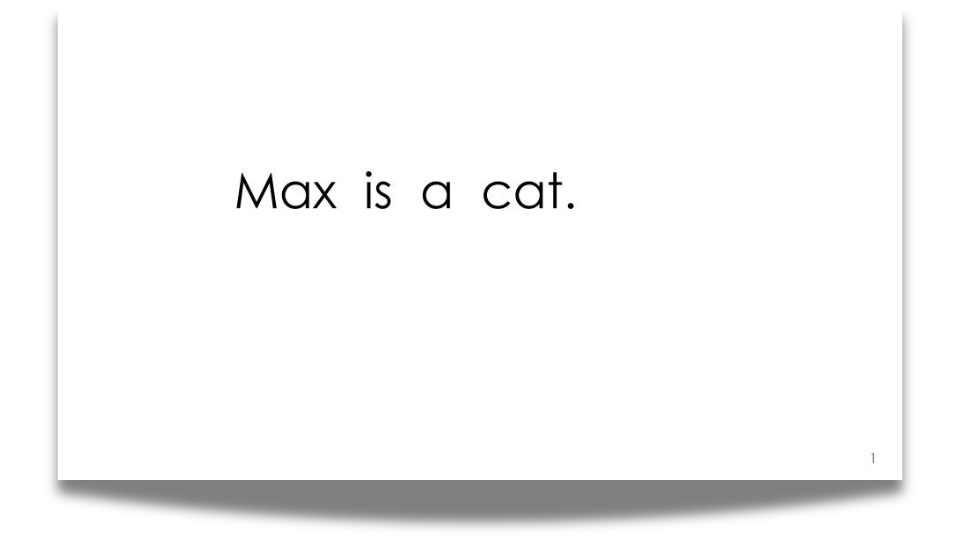
And after children decode page one, they can turn the page to confirm their efforts with the meaning the picture offers as they look at . . .
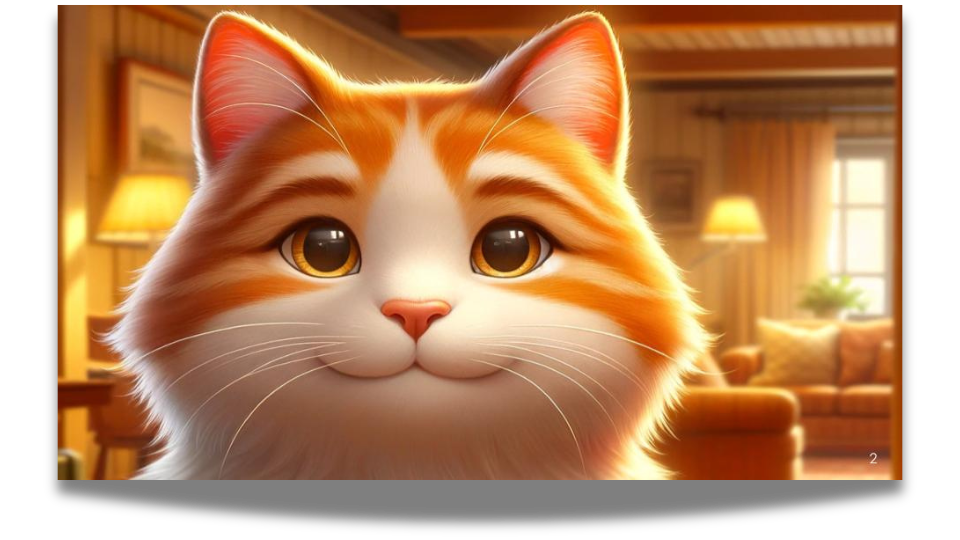
Max, the cat!
What Do Students Need to Know to Decode This Text?
To make exploring Cat Naps with children both practical and efficient for you, we’ve included an at-a-glance view of all the words in the text, listed in the order they appear. The table below (included on the last page of the book) divides the words up into less-regularly spelled high-frequency words (column 1), words that fit the spelling pattern that is the focus of the text (column 2), and other “words” or features that students will encounter (column 3). Use this at-a-glance reference to make sure students have the phonics skills they need to practice decoding in Cat Naps.
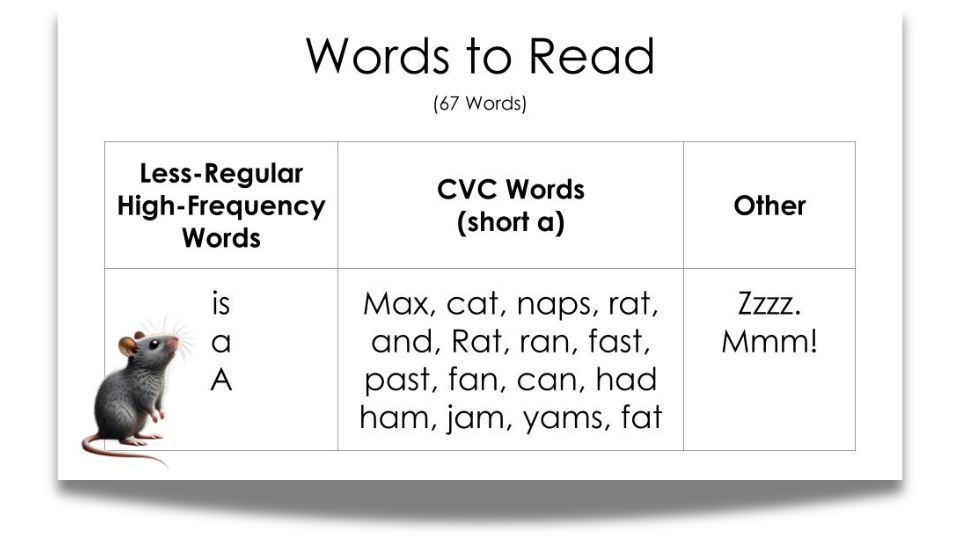
You can see that we wrote Cat Naps to give students opportunities to practice Short A, which is usually an important early choice for very beginning decoders as they work hard during the full-alphabetic phase of word reading.
What Do Students Need to Know to Comprehend This Decodable Text?
But again, decoding isn’t reading if it doesn’t involve language comprehension. To support you in thinking about the comprehension side of the reading equation, we’ve included a list of ideas for conversation before, during, and after reading. The language required to understand this text is relatively simple, but there are a lot of opportunities for young readers to think deeply. After all, reading is thinking.
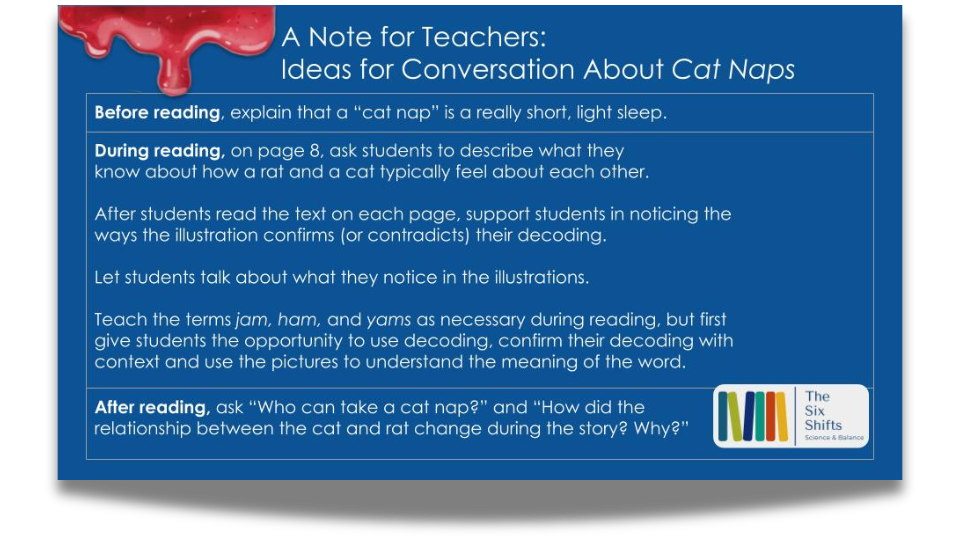
Additional Tools for Sharing This Free Decodable Text With Children
There are lots of ways to use a strong decodable text with children. You know your students, and who in your class will benefit from reading Cat Naps. To give you enough flexibility to use the text in a variety of instructional contexts, from whole-group shared reading to providing individual hard copies for independent practice, we offer Cat Naps in three different formats:
1. A DIGITAL FLIPBOOK
This version of Cat Naps is an electronic flipbook for you to project and explore with students as a shared text. You can also share this blog post with children and families so they can access the flipbook.
Tap below to explore the digital flipbook.
2. A PRINT-AND-ASSEMBLE PDF
The full-color PDF of the whole book is ready for you to print, assemble, and share to provide children with a physical copy of the text for use in small groups, independent practice, or as a take-home tool. The steps for printing and assembly are below. Don’t worry that the pages are out of order; that’s important for printing.
Note: Although you will have full license to download the PDF and make all the copies you need for your own students, we ask that you send other educators to our site to download their own copy. This will help us keep this and other resources free.
3. A PRINTABLE ONE-PAGER (text only)
We’ve also made a printable, single-page document to offer students more high-volume practice. Print the page of text and place it in a folder, binder, or sheet protector for individual students. There’s also a space for students to color in a cat’s face with each successful reading. This one-pager even includes a bonus page for students to draw and write about Cat Naps. Of course, drawing and writing are supported by conversation, so remember to give students opportunities to talk about the story before they draw and write and then again about their pictures and sentences afterward. Finally, this tool is for after reading the book. We do not recommend using this one-pager with students who have not experienced the full-text, which includes the page breaks and illustrations.
We’ve had fun experimenting with AI tools to create this text for you. We hope you and your students will have as much fun reading, thinking, talking, and writing about cats, rats, and naps as we have! And we hope you can catch a cat nap soon! You deserve it.
Zzzz . . . Zzzz. . . ❤️
-

Jan Burkins and Kari Yates are authors, speakers, and consultants, who are dedicated to helping teachers around the world translate reading science into simple instructional moves that help teachers make learning to read easier for their students while still centering meaning-making, engagement, and joy.
Recent Posts

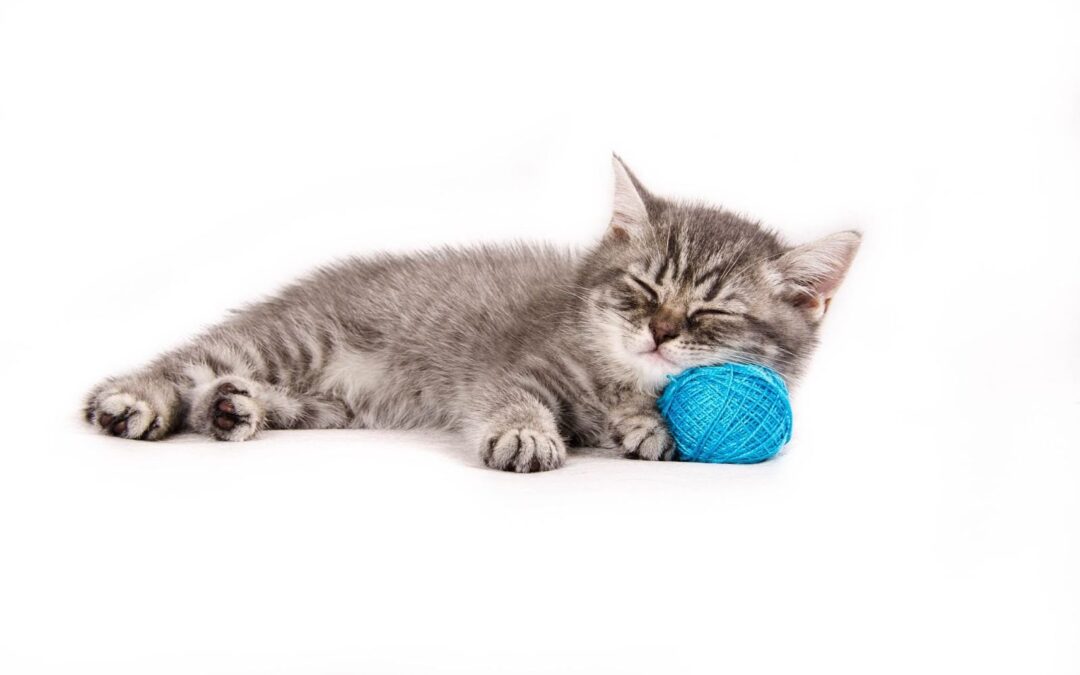
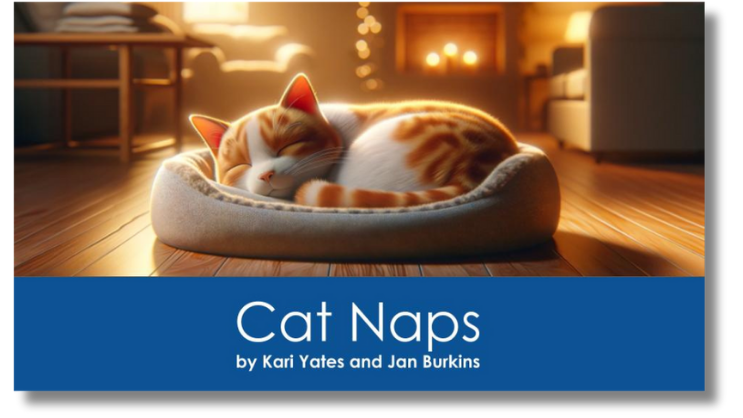
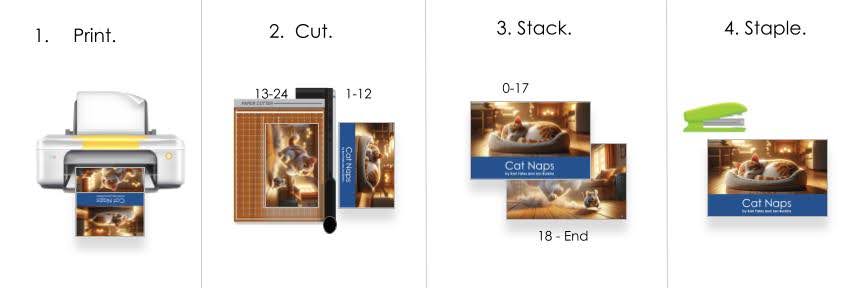
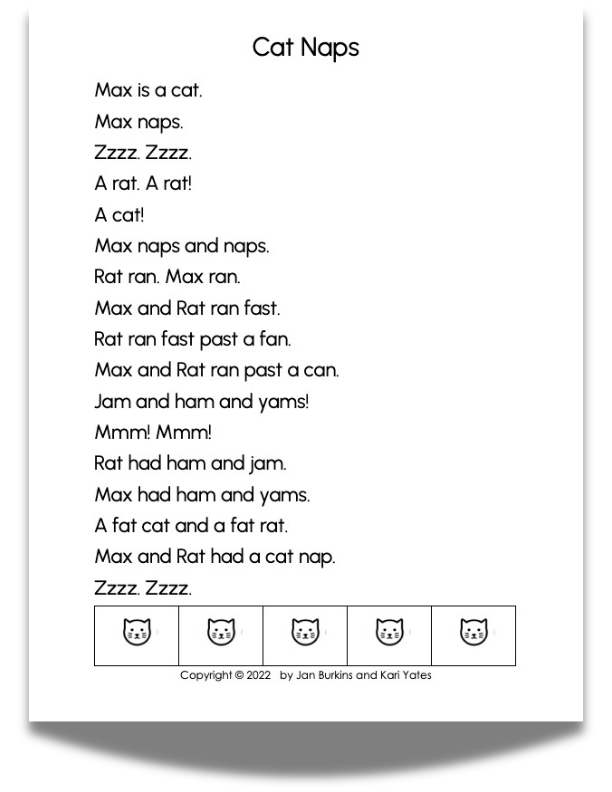


How can I access “A Pup Can”?
Hi Valerie. Here is the blog post about A Pup Can. And here is the download page for the Print-and-Assemble PDF.
This is amazing. Thank you for all you do. I am not seeing the link to the print and assemble book. Am I missing it??
Thank you, Stephanie! 😊 We’re so glad you’re excited about Cat Naps! You can find the print-and-assemble book at this link: Cat Naps – Print and Assemble PDF. If you’re still having trouble accessing it, let us know—we’re happy to help! 📚✨
Not sure this would work in Australia as the ‘a’ in fast and past are pronounced ‘ar’ not short a.
My school also started creating decodable books using AI for illustrations to replace A-C leveled Fountas and Pinnell benchmark books.. We also put the text in isolation so students would read that first to figure out the words and then the second read is with the picture book for context and cement comprehension. It has helped us fill a gap for progress monitoring since we eliminated assessing Kindergarten and First grade with Fountas and Pinnell assessments. So neat to see that you were thinking the same thing. We are testing out our assessments this school year before we launch them in our district. Progress monitoring is very important at the early ages. Thanks for sharing!
Maura, this is so exciting to hear! 🎉 The shift from A-C leveled books to decodable texts is such a powerful move for early readers, and we love how you’re leveraging AI-generated illustrations to create engaging, structured texts. Your approach—having students read the text in isolation first and then integrating the picture for comprehension—is a fantastic way to build decoding confidence while ensuring meaning-making stays central. We’d love to hear how your assessments evolve this year—progress monitoring is such a critical piece in ensuring all students are moving forward. Keep us posted! 📚✨
HI,
I do not see the link to download the book?
https://thesixshifts.com/downloads/cat-naps-print-and-assemble-pdf/
Where is the link to print the book? I can’t find it:)
You can find the Cat Naps print-and-assemble book here: https://thesixshifts.com/downloads/cat-naps-print-and-assemble-pdf/
This was the CUTEST book, and my students were incredibly engaged!!
The AI images were ADORABLE, and completely hooked them into the story! Well done! If you make more, please share! <3
Thank you for these exceptional, kid-friendly, and brain-enriching resources. I’m constantly looking for decodables that offer both phonetic practice and meaningful information.
I’m required to teach a program (SoR approved) that includes a vocabulary structure I’m not in love with. I will show your template to our principal since I find it much more effective.
THANK YOU!
Thank you! This has been a helpful and engaging resource! I like having both the print and projectable options, as well as the teaching points.